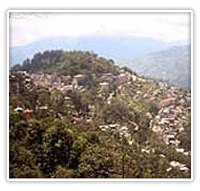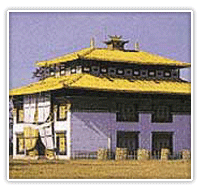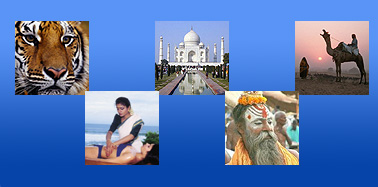|
|
|
|
|
|
|
Home » Hill
Stations in India » Hill Stations in East India »
Gangtok
|
|
|
|
Gangtok
|
|
|
|
 Gangtok, the "Lofty Hill" or the "Hill made flat to build the Gangtok monastery in 1716". Gangtok is a city, which, till one sees it, one would believe exists only in picture-story books. In the mystery-laden mists prayer flags whip in the breeze; wheels spin in the hands of Lamas mumbling invocations to God, in the distance are the snows, on the streets amidst brightly painted pagoda roofed houses, lined with friendly smiling people are silver, silk and spice and jewellery to gladden an maiden's heart, from across the seven seas are gadget and goods to delight the collector of "imported goods', while directly overlooking the city is the hill Lukshyma, the 'Mother of Pearl' citadel of the magic mountain, Khang-Chen-Dzod-Nga. Gangtok, the "Lofty Hill" or the "Hill made flat to build the Gangtok monastery in 1716". Gangtok is a city, which, till one sees it, one would believe exists only in picture-story books. In the mystery-laden mists prayer flags whip in the breeze; wheels spin in the hands of Lamas mumbling invocations to God, in the distance are the snows, on the streets amidst brightly painted pagoda roofed houses, lined with friendly smiling people are silver, silk and spice and jewellery to gladden an maiden's heart, from across the seven seas are gadget and goods to delight the collector of "imported goods', while directly overlooking the city is the hill Lukshyma, the 'Mother of Pearl' citadel of the magic mountain, Khang-Chen-Dzod-Nga.
An air of enchantment hangs over the city, indeed the whole valley; the mysticism, the stupas, the monasteries reach out as soon as one has crossed the border. While across the hills and valleys comes the sounding of the long trumpets by robed lamas.
Prime Attractions of Gangtok
Deer Park
Adjacent to the new secretariat and also called the Rustomji Park named after one of the Dewans of the Chogyal of Sikkim, the park has a big open enclosure in which animals native to Sikkim like the red panda and the Himalayan Bear are kept. A big statue of Lord Buddha commemorating his preachings of the noble truths in the Deer Park at Sarnath adorns the park premises. A butter lamp perpetually burns in front of the statue, which is surrounded with flowers of exotic variety. The park commands a fantastic view of the hills, surrounding Gangtok.
Dul-Dul Chorten
Duddul Chortenat Dotapu Chorten, Gangtok was built under the supervision of the late Most Venerable Trulshi Rinpoche after due preparations in 1945-46, in accordance with the prophecy made in 1944 by the Holiness the
Dud-Zom Rinpoche.
Government Institute Of Cottage Industries
This institute is located at about half a kilometre uphill from the main market of Gangtok. It was established with the purpose of promoting the manufacture and sale of local handicrafts. Thankas (also spelt as Thangkas), hand carved wooden tables - known as Choksees and exquisitely woven woolen carpets. More than hundred student workers turn out cottage crafts produced here, with textures, plush and exotic, the designs varying from sophisticated simplicity to a brilliant riot of varmillion pitted against intense blue, are durable and popular all over the world second to carpets in popularity is Sikkimese Tankhas, variegated appliqué work Batiks and exquisite dolls, in wood-work are available intricately carved Sikkimese tables, hand-painted masks, lamp-stands, shades and bamboo-craft. Esoteric masks, flashing silks, opulent brocades and embroidered boots, clothe the Sikkimese dancers.
 Kabi Longstok Kabi Longstok
25-km from Gangtok, just before Phodong is Kabi Longstok. There is a spot amidst tall trees, where the treaty of brotherhood between, the Lepcha Chieftan - Tetong Tek and the Tibetan chief Khye Bhumsa was signed.
Kangchendzonga National Park
Crossing a check gate where visitors entry permits was checked, one enters the Kangchendzonga National Park. The climb is gradual but very interesting as soon one is greeted by snow, lying white and pristine over the green forest floor and covering a few treetops. The jagged, rocky slopes to our left glistened in the sunlight at places forming glaciers where the gradient was right. The mountains to our right were covered with dark green pines; the snow line being much higher.
Kechopari Lake
On bifurcation road between Gyalsing and Yoksum, is clear water Kechopari Lake (means - wishing lake). All around are mountains with dense forests and wild life. It is so placid, crystal clear that not a leaf can be seen floating over it, because it is immediately lifted by birds.
Labrang Monastery
A kilometre further from Phodong, the Labrang monastery was built about 100 years later. This monastery belongs to the Nyingmapa sect of Tibetan Buddhism, the same as that of Pemayangtse monastery in West Sikkim. Its name translates simply as the dwelling place of the Lamas (monks).
Lachung
The road from Chungthang toward Lachung takes one into another world. This is the area inhabited by the Lachungpas, a hardy mountain people who consider themselves quite different from the Bhutias and the Tibetans. The lush green, terraced hillsides, even in winter, were a testimony to the grit and determination of these people. Lachung is the last habitation on the road to Yumthang a monastery; hidden high on the hillside overlooked a settlement of Lachungpas and barracks of the Indian army. The mountains on the other side of the valley rose up to snowy heights. In the distance, one could see the impressions of a track that was once used by traders to cross over from Tibet with their mules laden with Chinese silk.
Pemayangtse Monastery
Around 6-km from Gyalsing town, this monastery originally built as a small temple in the last of 17th century by Latsun Chempo, later rebuilt the temple structure into a monastery.
Phurchachu Reshi Hot Springs
Around 25-km from Gyalsing, near Reshi, after crossing Rangeet River (also spelt as Ranjit) by a pedestrian bridge, hardly ten minutes from the highway is Phurchachu springs with medicinal properties, ideal for skim diseases. These springs are considered holy as one of the four holy caves is located here. This holy cave is called the "Kadosangphu" or 'Cave of the occult fairies' and lies on the south of the four cardinal points.
Research Institute of Tibetology
In the serene surrounding amidst forest of oak, ash and birch is an organisation to advance the Tibetan language and its literature on the "Enlightened one", the only one of its kind in the world of Mahayana Buddhism. Ornate woodcarvings and murals decorate the lavishly decorated interior.
Rumtek Monastery
A 24-km drive from Gangtok, through the beautiful, bewitching countryside leads one to Rumtek. Rumtek, is the seat of the Karmapa Lama who heads the Kagyupa Sect of Buddhism.
Tasuklakhang - The Royal Chapel
The Royal Chapel, Tsuklakhang, is within the palace grounds. Popularly called Tsulakhang Royal. It is the principal place of worship and assembly and the repository of a vast collection of Buddhist scriptures.
The Ridge
The ridge is a small stretch of plain and flat road above the town of Gangtok. It is just about five minutes walk from the main market. The ridge has the white hall and the chief minister's official residence on one end and the beautifully designed palace gate on the other. The ridge is lined with plants and trees when in bloom are a riot of colours. Flower shows, which attract tourists from all over the world are held just below the ridge.
Tsomgo Lake
Tsomgo literally means "Source of the Lake " in Bhutia language. ' TSO' means lake and ' MGO' means head. At about 40-km away from Gangtok, this serene and holy lake is situated at an altitude of 12,400 ft on the Gangtok - Nathu La highway.
White Hall
It was built in 1932 in memory of the first political officer of Sikkim, Claude White. There is an Officers Club and a Badminton Court in the white hall.
Yaksey
Yaksey, a tourist lodge, 6-km from Lachung towards Yumthang is an ideal place for tourists to this area. Another 23-km leads to Yumey-Samdong hot springs near river Sebu-Chu at the foot of Donkia-La pass, which connects Lachung valley to Lachen valley.
|
|
|
|
|
|
| |
|
|
|
|


